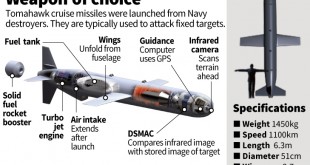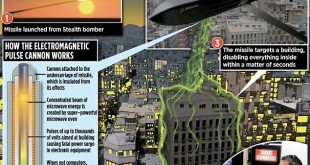Missile guidance concerns the method by which the missile receives its commands to move along a certain path to reach a target. On some missiles, these commands are generated internally by the missile computer autopilot. On others, the commands are transmitted to the missile by some external source. The missile sensor or seeker, on the other hand, is a component within a missile that generates data fed into the missile computer. This data is processed by the computer and used to generate guidance commands. Sensor types commonly used today include infrared, radar, and the global positioning system. Based on the relative position between the missile and the target at any given point in flight, the computer autopilot sends commands to the control surfaces to adjust the missile’s course.
Homing guidance is the most common form of guidance used in anti-air missiles today. Active homing works just like semi-active except that the tracking energy is now both transmitted by and received by the missile itself. No external source is needed. It is for this reason that active homing missiles are often called “fire-and-forget” because the launch aircraft does not need to continue illuminating the target after the missile is launched.
Active homing missiles typically use radar seekers to track their target. These seekers are also sometimes called monostatic because, unlike semi-active guidance, the transmitted and reflected waves are at the same angle with respect to the line of sight between the missile and target. Examples of active homing missiles include the AMRAAM air-to-air and Exocet anti-ship missiles.
In recent years, precision guided weapons play more and more important role in modern war. One of the greatest strengths of a precision strike missile is a reduction in the number of aircraft sorties required to destroy a target. One of the key contributors to the missile accuracy, lethality, and adverse weather capability of precision strike missiles is the advancements in missile seekers. Precision guided weapons may include a variety of imaging or non-imaging sensors to detect and track potential targets.
Sensors used to guide projectiles to an intended target are commonly referred to as seekers. Seekers may operate in various portions of the electromagnetic spectrum, including the visible, infrared (IR), microwave, and millimeter wave (MMW) portions of the spectrum. Some projectiles may incorporate multiple sensors that operate in more than one portion of the spectrum. A seeker that incorporates multiple sensors that share a common aperture and/or common optical system is commonly called a multimode seeker.
Market
The global missile seekers market size is projected to grow from USD 5.3 billion in 2021 to USD 6.8 billion by 2026, at a CAGR of 5.2% from 2021 to 2026.
Infrared Technology: The largest segment of the Missile Seekers market, by Technology.
The infrared technology is projected to dominate the missile seekers market during the forecast period. Infrared technology is capable of tracking the heat generated by an object. In missile guidance systems, infrared tracks the target based on the heat generated by it. Infrared is a passive type of homing technology which is effective in anti-aircraft missiles as it detects the heat generated by the jet engines of aircraft. Cross-array seekers and rosette seekers make use of infrared technology to guide missiles.
Interceptor: The fastest-growing segment of the missile seekers market, by Missile Type.
Based on the missile type, interceptor missiles is projected to grow at the highest CAGR for the missile seekers market during the forecast period. Interceptor missiles are anti-ballistic missiles used to counter ballistic missiles like intercontinental and intermediate-range ballistic missiles launched from any enemy country and to counter aircraft and other missiles. S400, Arrow 2, Arrow 3, THAAD, Patriot missile defense system, and Barak 8 are interceptor missiles used to defend against any kind of airborne threats, such as helicopters, aircraft, UAVs, anti-ship missiles, and ballistic missiles.
The increasing procurement of interceptor missiles by countries such as India, South Korea, and Israel due to rising geopolitical instabilities is driving the growth of the interceptor missile segment. For instance, in 2018, the Indian government signed a contract worth USD 5.43 billion with the Russian government to procure five regiments of the S-400 missiles.
Air-to-Air: The fastest-growing segment of the missile seekers market, by Launch Mode.
Based on the launch mode, the air-to-air segment is projected to grow at the highest CAGR rate for the missile seekers market during the forecast period. Air-to-air missiles are launched from aircraft, helicopters, or unmanned combat aerial vehicles (UCAVs) to destroy enemy aircraft. The warhead types of air-to-air missiles are fragmentation warheads or continuous rod warheads. These missiles detect their targets using radars or infrared guidance systems and can fly at a very high speed. These missiles are long and have narrow cross-sections to reduce drag.
North America: The largest contributing region in the missile seekers market.
North America is projected to be the largest regional share of the global missile seekers market during the forecast period. Major companies, such as Raytheon Technologies, Northrop Grumman Corporation, and SemiConductor Devices, and small-scale private companies, such as Excelitas Technologies Corp, Marotta Controls, and KODA Technologies Inc., are based in the US. These players continuously invest in the R&D of new & improved missile seeker designs.
The missile seekers market in North America is driven by the increasing need for advanced defense systems from the US military. Missile seekers are the systems used in missiles to guide them on the right trajectory to accurately hit the desired targets. Recent technological developments in defense systems, including guided missiles, have led to the increased demand for more efficient missile seekers.
Market Dynamics
The market is driven by various factors, such as geopolitical instabilities Leading to Procurement of Advanced Missile Systems, changing nature of warfare, increasing defense expenditure of emerging economies and technological advancements in missile seekers.
The major factor driving the missile seekers market is the changing nature of warfare. The advancements in technology have led to the development of new and advanced defense systems, including air defense systems and guided missiles
for hitting moving targets. The changing nature of warfare across the globe has led to the acquisition of advanced missile firing and defending capabilities by militaries of various countries. These militaries are increasingly engaged in low-intensity battles.
One example of the changing nature of warfare was the Indian military’s reply to the Pulwama attack, where the Indian Air Force fighter planes destroyed a terrorist camp in Balakot (Pakistan) using guided missiles.
Advanced missile defense capabilities help countries in defending themselves against rocket and missile attacks. For instance, Israel’s Iron Dome air defense system prevented more than 2,500 missile and mortar attacks with a
success rate greater than 90%. The missile seeker in such a system plays the most important role of making sure the missiles fired by the defense system hit the targets accurately. This fueled the development of more advanced air defense systems, which use ground-to-air missiles with guided seekers, with a success rate greater than 90%.
Thus, the changing nature of warfare has resulted in the increased demand for highly advanced seekers for missiles from militaries across the globe.
Restraints
- Procurement of Conventional Warfare Systems Rather Than Advanced Precision-Guided Munition by Many Countries
- High Manufacturing Cost
Opportunities
- Miniaturization of Missiles and Their Components
- Support for Researchers and Manufacturers for Developing Missile Seeker Solutions
- Depleting Stock of Precision-Guided Missiles
Challenges
- Delivering Products of Highest Standards Every Time
- Regulations on the Use of Missiles
Segments
Based on technology, the multi-mode technology are projected to grow at the highest CAGR rate for the missile seekers market during the forecast period. Multi-mode guidance systems make use of two or more missile seeker technologies to improve accuracy. Terrestrial Guidance (TERCOM) is one such hybrid system that uses radar, global positioning system (GPS), and digitized scene mapping area correlator (DSMAC) together. Multi-mode missile seeker is used for guidance of cruise missiles like AGM-86B (US), C-602 (China), Hyunmoo-III (South Korea), etc.
The missile seekers market includes major players BAE Systems (UK), Boeing (US), Leonardo S.p.A. (Italy), Raytheon Technologies (US), Safran Group (France), Thales (France), and Northrop Grumman Corporation (US). These players have spread their business across various countries includes North America, Europe, Middle East, Asia Pacific, and Rest of the World. COVID-19 has impacted their businesses as well. Industry experts believe that COVID-19 has slightly affected missile seekers production and services globally in 2020.
Key Companies are
- Adani Aerospace & Defence
- Analog Devices
- Aselsan As
- Bae Systems
- Bharat Electronics Limited
- Boeing
- Defence Research & Development Organisation
- Diehl Defence
- Excelitas Technologies Corp.
- Janos Technology LLC
- Koda Technologies Inc.
- Kongsberg Defence & Aerospace
- Leonardo S.P.A
- Marotta Controls
- Mbda Missile Systems
- Northrop Grumman Corporation
- Radionix
- Rafael Advanced Defense Systems Ltd.
- Raytheon Technologies
- Safran Group
- Semiconductor Devices
- Tata Advanced Systems
- Thales
- Tonbo Imaging
- Vem Technologies Pvt. Ltd.
References and Resources also include:
https://finance.yahoo.com/news/missile-seekers-market-technology-missile-163000762.html
 International Defense Security & Technology Your trusted Source for News, Research and Analysis
International Defense Security & Technology Your trusted Source for News, Research and Analysis


